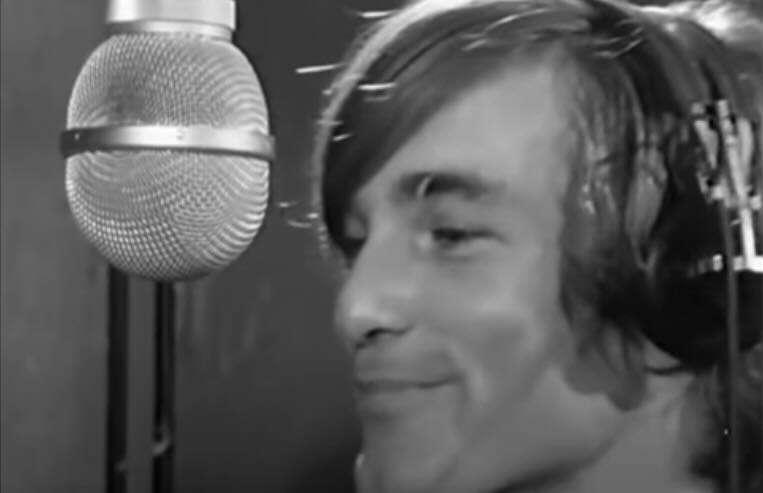 Many thanks to SWLing Post contributor, Mark C, who writes:
Many thanks to SWLing Post contributor, Mark C, who writes:
Thomas,
You have posted numerous photos of radios appearing in film. I found something similar but with an interesting twist.
The link is to the YouTube clip Good Vibrations the Lost Studio Footage. Watching the Beach Boys singing that iconic musical selection is thrilling enough but I would have never guessed I would be seeing them wearing the military HB-7 and using them as studio headphones while they were performing!
Good Vibrations the Lost Studio Footage
Click here to view on YouTube.
Sincerely,
Mark
That’s just brilliant, Mark. Thank you for sharing this. I would have never guessed HB-7s would be used in a studio setting, but it certainly looks like them in the video.
I have to thank you for sharing this lost footage of the Beach Boys, too. This was new to me. I love the song, too; certainly iconic!

A surprising sight but maybe not *that* surprising: Skipping the pre-war history, on the US market, the first commercially available headphones for music (Koss SP-3) were introduced only 1958 and they were quite expensive. Also, headphone usage in studios just had become a thing because “overdubbing” was still a new production concept that had just begun to pick up momentum and having larger quantities of performers needing them for monitoring was a new challenge. I guess the money for a single pair of Koss cans bought them their entire stock of surplus headphones. 🙂
Also, if I got that right, “HB-7” was just the designator for the head band number 7, which could be equipped with different “receivers” for different purposes (e.g. ANB-H1 , R14) and separate cushions for them. They were likely all 600 Ohms or similar, so it was relatively easy to have a whole bunch of them wired in parallel in a breakout box hooked up to pretty much any kind of amplifier.
17. June 2022
13dka
Of course, you are correct about the HB-7 designation, it is for the headband. I couldn’t say it was an HS-23 or HS-33 because I didn’t know what receivers were used; R14 (2000 ohm) or ANB-H-1 (300 ohm). Without further information, to say they were wearing the HB-7 was the safest option. However, I think I can also say the rubber earpieces look very similar to the MX-41/AR. After using the chamois earpieces NAF-48490-1 for awhile I switched back to the MX and preferred them.
In a couple of scenes I see those headphones with a Y-cord. Could they have been wired for stereophonic sound feeding each receiver independently? That’s what I did with my HS-33 in 1970 for my first set of stereo headphones; then I got a set of Koss PRO/4AA in 1972. Perhaps the wiring scheme was just a repair or alteration to eliminate the redundant and bulky plug and jack combination.
There is the question about sound quality. Those headphones were for communications and not for high fidelity sound; what would the artists say about them. Perhaps, studio speakers were the last word for getting the sound finished just right.
With regard to the selection of military surplus headphones for studio application. At the time they were recording that song late 1966 in Los Angeles I was living 370 miles to the northwest near a little town called Novato (north of San Francisco); I was a brat at Hamilton Air Force Base. We had a language lab (Spanish) at San Jose Jr. High School and the classroom was outfitted with Telex headsets with microphones. A search though the electronic catalogs of the times reveals other headphones that might have provided better sound than the HS-23 or HS-33. One thing is for sure, those old headphones could take a beating. My HS-33 manufactured by the Rola Company, Inc. has a long crack in the Bakelite case in one receiver element but still provides excellent sound. I only stopped using them because one-quarter inch headphone jacks are somewhat of a rarity these days.
I can almost say with 100 percent certainty that after the song was released I heard it early 1967 using my own pair of HS-33 headphones (a gift from the base MARS station AG6HQ — thank you) and Knight Kit Star Roamer — while tuned to KFRC – The Big 610.
I sailed the world using those headphones and they were with me during Operation Desert Shield/Storm. They were probably the reason why my bag was ripped open at the airport in Pisa; perhaps the headphone cables on X-ray looked mightily like detonation cord to the Italians.
Mark
Hi Mark,
Thanks for sharing that story! Finding out they used the same cans to record this iconic song as you were using to hear it is sure bringing up memories! They were with you all your life it seems.
As for studio usage, except for monitoring purposes, even high-end headphones actually didn’t catch on in studios until pretty recently – audio engineers usually feel they do not represent the mix balance as speakers do, which is certainly correct given that headphones are not only stereophonic, they are binaural and – for example – they make panning instruments to the extremes in the stereo image sound awkward. Also, their frequency response is much depending on seat/individual anatomy so they don’t lend themselves to assessing tonal balance like studio monitors do.
Here’s a clip from the “Omnibus” show in the 50s featuring Les Paul and Mary Ford, I copied the link with a time mark giving a more closeup shot of Mary using headphones:
https://youtu.be/BjKX0P4t_ac?t=460
Obviously it wasn’t that uncommon to use those in a recording context and maybe they were not that bad even, but their sound certainly did not play a role back then…yet. Using headphones as a well-sounding alternative to hifi-speakers really took off in the late 60s and 70s only with more affordable products popping up everywhere.
Ollie
Beautiful